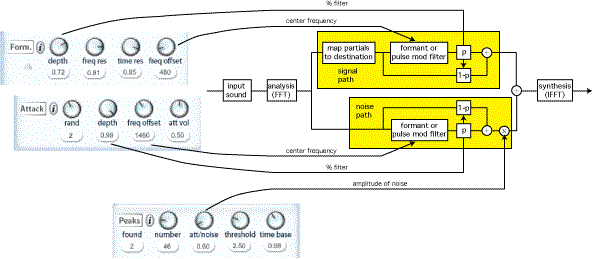

Block Diagram of the TransFormSynthThe input sound is broken into frames and then analyzed by an FFT. The partials or overtones of the sound (the peaks of the spectrum) follow the top path while the noise follows the bottom path.
The partials are mapped to their destination frequencies by a spectral mapping and then filtered by either a formant filter or a harmonic filter. The center frequency of the filter is specified by the 'freq offser' dial 8 while the 'depth' dial 5 determines how much of the filtered sound is passed. Similarly, the noise portion is filtered by either a formant filter or a harmonic (pulse modulation) filter. The center frequency of the filter is specified by the 'freq offset' dial 10 while the 'depth' dial controls how much of the filtered sound is passed. 
The dial labelled 'att/noise' adjusts the balance between the top and bottom paths. Increasing the value of the dial tends to increase the volume of the attack portion of the sound. Decreasing the dial to zero will remove the attack altogether. The dial also effects continuous noises (such as the windblown breathiness of a flute). These can be emphasized by increasing the dial and attenuated by decreasing the dial. |
©2008 William Sethares; site design by Anthony Prechtl |